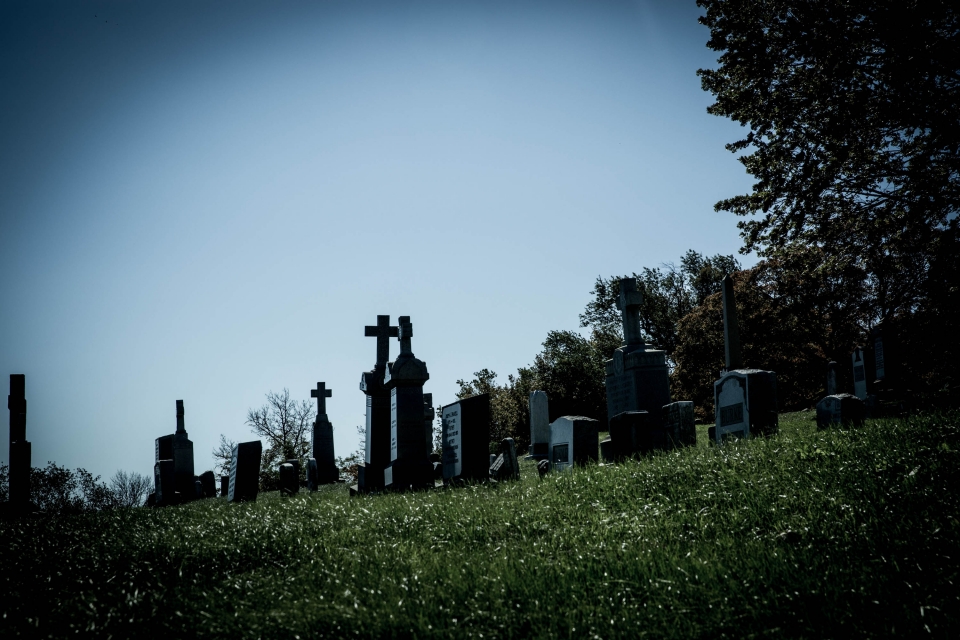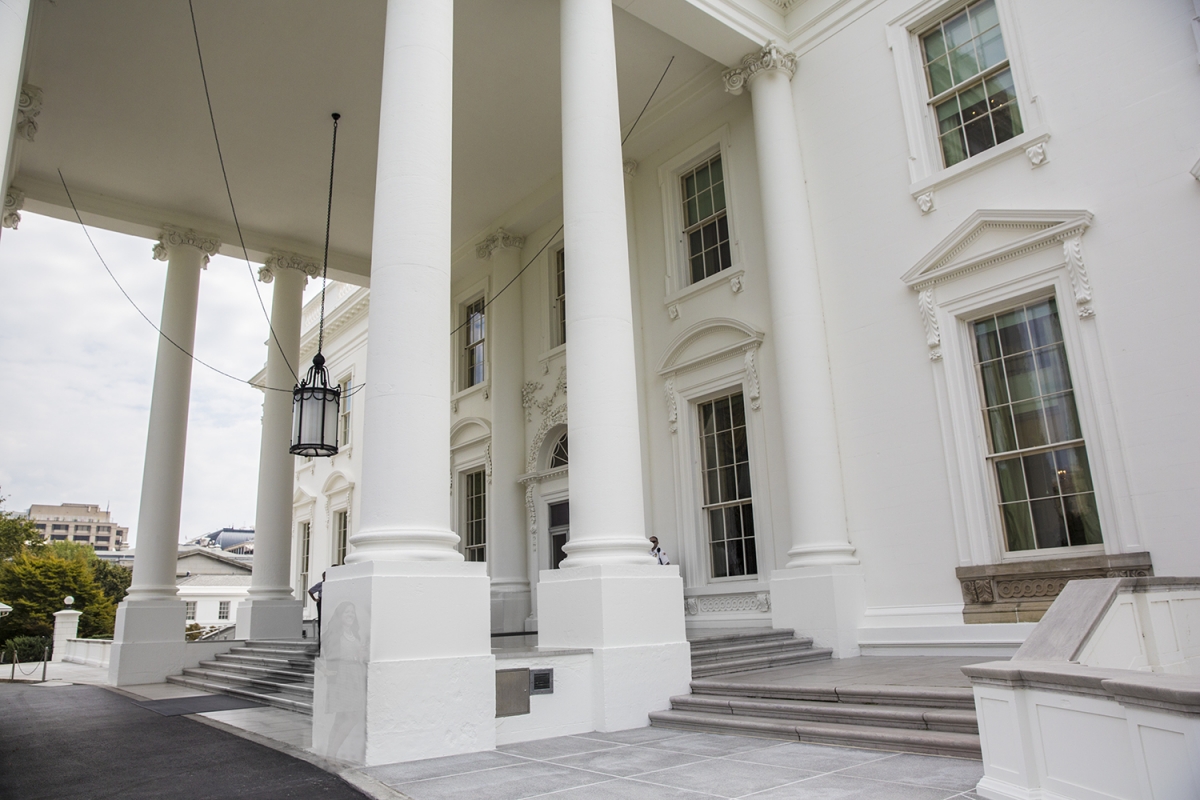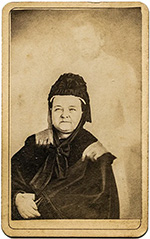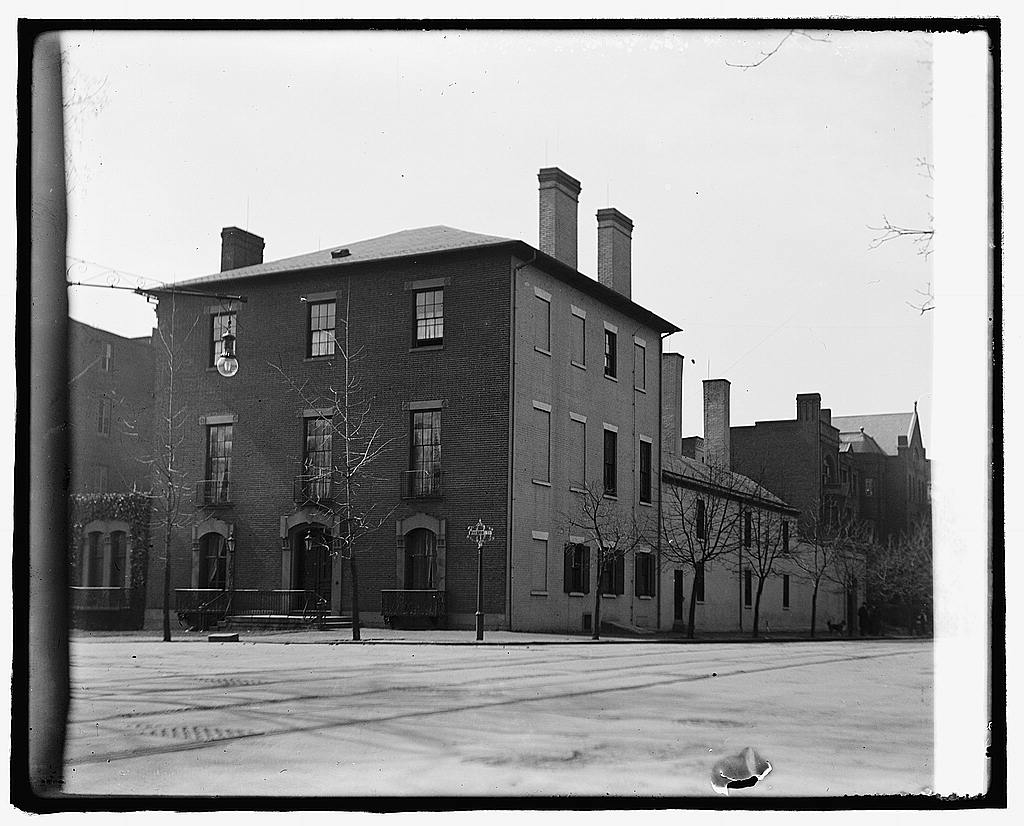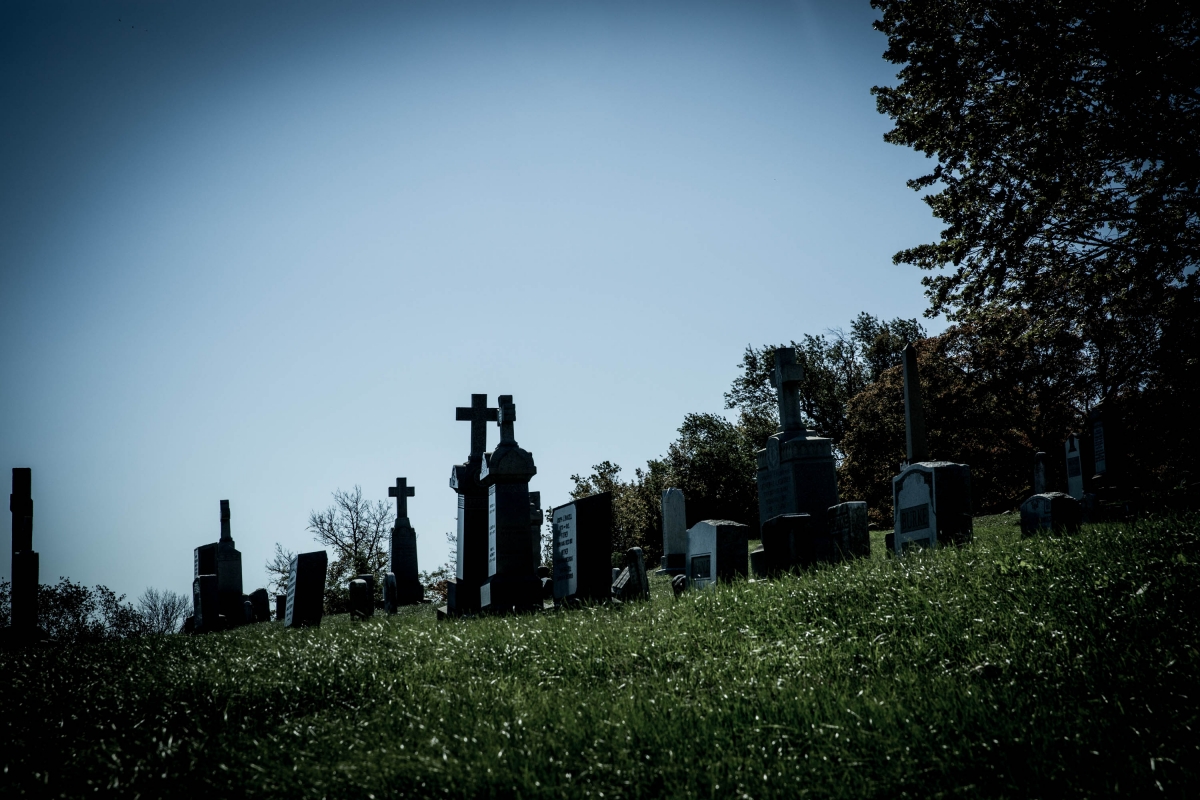Does a demon cat roam the U.S. Capitol Building? Why are the windows bricked up in a home that overlooked a famous 19th-century tragedy? Which World War II leader supposedly saw Lincoln's ghost—while naked? Local historians, would-be paranormal investigators and Halloween enthusiasts at the George Washington University are in luck: when it comes to the haunted history of Washington, D.C., there are plenty of eerie stories to pursue. For spooky season, GW Today rounded up the history of some of the best-known ghost sites in the nation’s capital. Scroll down…if you dare.
The White House
The Octagon House & Museum
Decatur House
The Hay-Adams Hotel
Oak Hill Cemetery
The Exorcist Steps
The Old Stone House
Holy Rood Cemetery
Lafayette Square
U.S. Capitol Building
The White House
1600 Pennsylvania Ave.
Schedule a free tour through your member of Congress
Reports of ghosts at the White House are legion. “The damned place is haunted sure as shootin’,” a creeped-out President Harry Truman wrote to his wife in 1946. Mary Todd Lincoln, an enthusiastic spiritualist, is said to have heard Thomas Jefferson playing the violin in the Yellow Oval Room and Andrew Jackson stomping and cursing in the Rose Room.
The White House’s most well documented phantom is Abraham Lincoln. The legend of Honest Abe’s ghost may have originated with longtime White House footman and raconteur Jeremiah “Jerry” Smith in the late 19th century, but it has since taken on a life—or an afterlife—of its own. First Lady Grace Coolidge told magazines that she had seen Lincoln’s specter gazing out a window of the room that had been his office. Nancy Reagan wrote in her memoirs that staffers attributed strange noises and missing items to Lincoln’s ghost and that the Reagan family dog would bark at the door of the Lincoln bedroom, refusing to enter. Even Hillary Clinton sometimes got the creeps: “There is something about the house at night that you just feel like you are summoning up the spirits of all the people who have lived there and worked there and walked through the halls there,” she told Rosie O’Donnell in 1996.
But Winston Churchill may have had the best—or at least the most vivid—Lincoln encounter. According to Mark Nesbitt in “Civil War Ghost Trails: Stories from America’s Most Haunted Battlefields”:
Winston Churchill, during his visits in the 1940s, never liked sleeping in the Lincoln bedroom… During one visit, after taking a hot bath (accompanied by a glass of scotch and omnipresent cigar) he emerged from the tub and strolled naked into an adjoining room where he ran right into Lincoln, who was leaning on the mantle above the fireplace. They looked each other in the face. Churchill was embarrassed. Lincoln simply vanished.
The Octagon House and Museum
1799 New York Ave., NW
Open Fridays and Saturdays, 11 a.m. to 3:30 p.m., adult admission $10
“The Octagon House has long had the reputation of being haunted,” author and socialite Mary Clemmer Ames wrote in 1873. The looming mansion where James and Dolley Madison lived after the burning of the White House in the War of 1812 is now home to the headquarters of the American Institute of Architects, and visitors still report cold spots and strange sensations on the house’s three-story spiral staircase. Other reported paranormal manifestations include poundings on the wall, floating spectral lights and the inexplicable ringing of servants’ bells: “It is an authenticated fact, that every night, at the same hour, all the bells would ring at once,” Ames wrote—neglecting to say who did the authenticating.
Boringly, historians have debunked the enduring legend that multiple members of the original builder’s family died in the house, including the gruesome rumor that a young daughter was killed on those creepy stairs. But just because the Octagon House's ghosts met their ends elsewhere doesn't mean they couldn't have returned to walk its halls.
Decatur House
748 Jackson Pl., NW
Free public tours available Mondays
Commodore Stephen Decatur was a celebrated naval hero and even a speculative presidential candidate when he commissioned this stately town house. Designed by renowned architect Benjamin Henry Latrobe and completed in 1819, Decatur House was the first residential home in the White House neighborhood and is now the home of the White House Historical Association. But just 14 months after moving in, Decatur was challenged to a duel and was killed. Two hundred years later, his spirit is said to gaze out the windows facing H Street just as he did on the night before the fatal duel—windows some say were bricked over to wall the ghost in and prevent him from frightening passers-by.
Unfortunately for this spooky local legend, Decatur certainly never stared mournfully out of these windows—because they were never not bricked over. These particular windows were designed “blind,” or bricked-up, to accommodate the house’s elaborate chimney and flue system while still adhering to the architectural sensibilities of the time. We admit they still look pretty creepy, though.
Hay-Adams Hotel
One Lafayette Sq., NW
In its 100-year history, the elegant Hay-Adams Hotel has hosted luminaries from Amelia Earheart to Angelina Jolie. The hotel’s supposed apparition was also a celebrity in her day: Marion “Clover” Hooper Adams, a socialite and accomplished amateur photographerwho grew up in Massachusetts’ Transcendentalist circles and was rumored to be the inspiration for Henry James’ “Daisy Miller” and “Portrait of a Lady.” The Hay-Adams was originally commissioned as a home for Adams and her husband, Henry Adams, but she did not live to see it completed. At the age of 42, she committed suicide using potassium cyanide, a darkroom chemical she’d often used to develop her photographs.
Though Adams never actually lived in the building, it’s said her presence is still felt there. The chandelier at the entryway to the hotel apparently sways at random, and a scent of almonds—or is it cyanide???—allegedly lingers in the halls.
With living guests as distinguished as those the Hay-Adams hosts, it’s understandable that staff are reticent on the subject of hauntings. Since tours are not offered, you’ll have to tag along one of D.C.’s many unaffiliated ghost tours to hear the legends in detail. You can, however, visit the hotel bar, Off the Record, where journalists and dignitaries have shared their own spooky stories for almost a century.
Oak Hill Cemetery
3001 R St., NW
Open daily. Hours may vary.
More peaceful than creepy, Oak Hill is the final resting place of many Washington notables, including Washington Post publisher Philip Graham and William Wilson Corcoran, founder of the Corcoran Gallery of Art. It also houses the less well known but, to our minds, equally admirable Jacob Fussell, whose legacy was opening the United States’ first wholesale ice cream house in 1851.
Oak Hill Cemetery also is the setting of George Saunders' Man Booker Prize-winning "Lincoln in the Bardo." The novel centers on the ghost of Abraham Lincoln's 11-year-old son, Willie, who was briefly interred here before being moved to Springfield, Ill., after his father's assassination in 1865.
The Exorcist Steps
3600 Prospect St. NW
A major character meets his end on this precipitous stairway in the iconic 1973 film “The Exorcist.” Accordingly, it’s a pilgrimage site for horror fans and for athletes, many of whom get their cardio fix sprinting up and down a rise equivalent to the height of a five-story building. According to Elizabeth Tucker’s “Ghostlore of American College Campuses,” during filming, Georgetown University students charged would-be spectators five dollars to watch a stuntman fall down 75 steps (fortunately padded with half an inch of rubber).
In fact, “The Exorcist” author William Peter Blatty was a Georgetown student himself when he first heard the story of a 14-year-old boy in Mount Ranier, Md., said to be possessed by demons—a story that would become the inspiration for the head-spinning, Satan-afflicted teen Regan MacNeil.
Old Stone House
3051 M St., NW
Open Fridays to Mondays, 11 a.m. to 7 p.m.
The Old Stone House is the oldest structure on its original foundation in Washington, D.C., and was already 59 years old when the British invaded the city in 1814. Now renovated, it retains much of its original flooring, paneling and walls. The house’s age practically guarantees haunting rumors, and they have indeed proliferated. There are at least 11 reported apparitions, including “a stout woman in an antebellum gown,” “a small boy named Joey” and “a German carpenter,” according to Dennis William Hauck’s “Haunted Places.”
The Old Stone House also is rumored to contain of one of D.C.’s few malevolent spirits. Known as “George,” it supposedly travels in an ominous cold spot and is said to have choked and pushed interlopers. But not to worry: George only manifests on the third floor, and only the house’s first-floor kitchen, which hosts a historical exhibition, is currently open to visitors.
Holy Rood Cemetery
2126 Wisconsin Ave., NW
Open daily, dawn to dusk
In its early days in the 1830s and 40s, the cemetery now known as Holy Rood was apparently notorious for sightings of the floating, luminescent orbs known as “witches’ heads.” Later commentators suggest these may have been phosphorus and other gas emissions from hundreds of unembalmed bodies in crude coffins, lying unmarked in the “Free Burial Ground” in the cemetery's northwest corner which was designated for burial of the poor.
Among these unnamed dead are, probably, more than 100 enslaved Black people—a fact known only because, until 1841, the cemetery’s death registry noted whether the dead were enslaved and to whom. The cemetery also is the final resting place of at least 500 free African-Americans, some of whom were former slaves or the children of slaves and most of whom were Catholic.
The nearly-200-year-old cemetery had fallen into disrepair when it was “rediscovered” and revitalized by neighbors, students and parishioners of the associated Holy Trinity Church. The "witches' heads" are long gone, and there are few if any reports of ghost sightings. Holy Rood is worth visiting, instead, for its meditative atmosphere and for the chilling history it reflects—the Washington, D.C. before emancipation, when a record-keeper could nonchalantly refer to an infant who had died after just a week of life as “the offspring of Mrs. Brooke’s slave, who stayed with Mr. L. Carbery.”
Lafayette Square
H Street and Jackson Place, NW.
These days Lafayette Square, directly in front of the White House, seems a more likely site for a protest than a ghost. But in 1859 the square saw one of D.C.’s most notorious slayings—committed in broad daylight by a sitting congressman.
U.S. Rep. Daniel Sickles (D-N.Y.) was notorious in his time for his extramarital dalliances. But when he discovered that his much-younger wife was having an affair of her own with Philip Barton Key, district attorney of the District of Columbia and the son of “Star-Spangled Banner” composer Francis Scott Key, he became enraged. According to a contemporary account, when Mr. Key passed the Sickles’ Lafayette Square house waving his handkerchief, Mr. Sickles—who believed his rival was making another adulterous overture—charged out and shot him twice.
Mr. Sickles’ was the first case in the United States to successfully use “temporary aberration of mind” as a defense. He would go on to a disastrous command at Gettysburg, where he went against orders, destroyed his battalion and lost a leg.
Cementing his reputation as one of the strangest figures in Civil War-era Washington, Sickles had his leg shipped to the National Museum of Health and Medicine in a small box with a card reading “With the compliments of Major General D.E.S.” The leg is still part of the museum’s collection in nearby Silver Spring, Md., which is well worth a visit for medical enthusiasts and general-interest ghouls.
U.S. Capitol Building
East Capitol St., NE and First St., SE
Open Monday to Friday, 9 a.m. to 3:30 p.m.; reservations required
Like the White House, the Capitol has seen too much history to be free of speculation about ghosts. Among its phantom inhabitants are said to be assassinated President James Garfield, architect Pierre Charles L’Enfant and John Quincy Adams, who had a stroke mid-speech on the floor of the House of Representatives and died two days later in an adjoining room. Capitol workers still report hearing him straining to finish the speech interrupted by his death. The building even has a “crypt,” apparently named purely for the vibes, since no one is actually buried there.
Not all of the Capitol’s specters are human. A “demon cat” supposedly prowls the 200-year-old building in times of national crisis, growing to enormous size and then vanishing. The apparition is even said to have left pawprints in the Small Senate Rotunda, where some original stones were replaced by concrete after a gas explosion in 1898. (The pawprints are real, though their demonic origin is uncorroborated.) One chief tour guide of the U.S. Capitol Historical Society posits, delightfully, that this legend may have sprung from a night watchman awakened from a drunken stupor by a scratchy lick—finding himself staring up at a perfectly normal-sized cat from a very unusual perspective.


